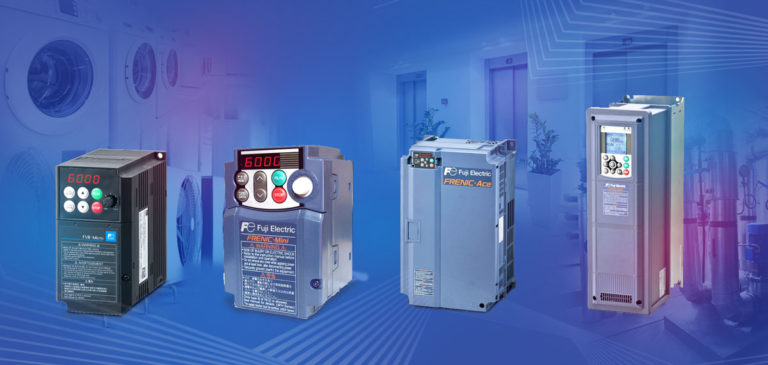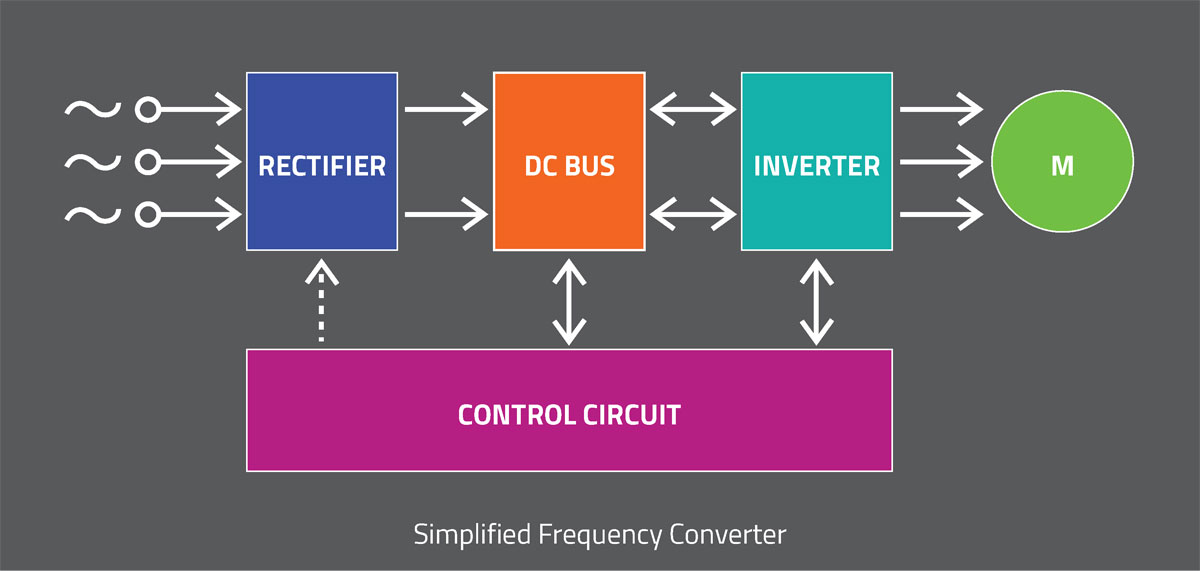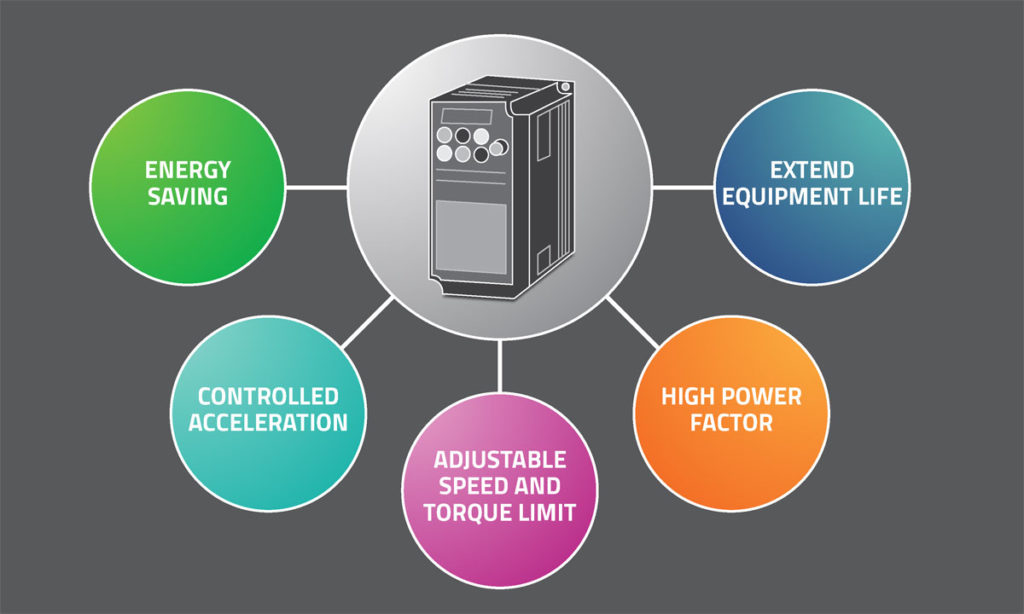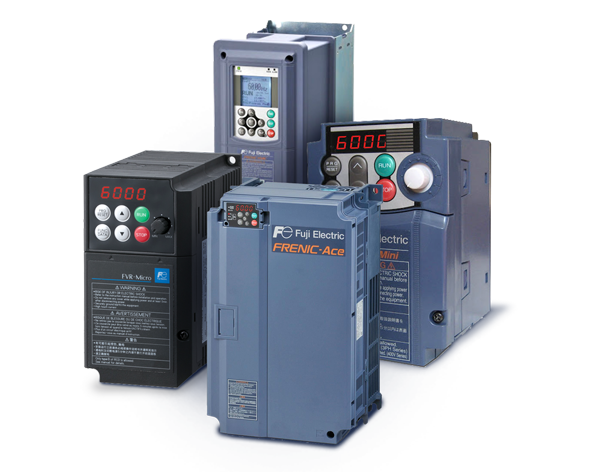
WHAT IS A VFD (Variable Frequency Drive)?
VFD full form is a variable frequency drive. So the obvious questions then are: what is VFD drive? Why do we use VFD? Advantages of VFD?
According to Wikipedia, “a variable-frequency drive (VFD) or adjustable-frequency drive (AFD), variable-voltage/variable-frequency (VVVF) drive, variable speed drive (VSD), AC drive, a microdrive or inverter drive is a type of motor drive used in electro-mechanical drive systems to control AC motor speed and torque by varying motor input frequency and voltage.”
This blog aims to explain VFD and introduce you to its basic features and functions.
WORKING OF VFDs
A variable frequency drive controls the speed of an AC motor by varying the frequency supplied to the motor. The drive also regulates the output voltage in proportion to the output frequency to provide a relatively constant ratio of voltage to frequency (V/Hz), as required by the characteristics of the AC motor to produce adequate torque.
To understand the VFD drive working principle or VVVF drive working principle, let’s study the four main VFD drive parts: rectifier, intermediate DC link, inverter, and controlling circuit.
Rectifier: It converts AC power fed from mains to DC power. This section can be unidirectional or bidirectional based on the application used like the four-quadrant operation of the motor. It utilizes diodes, SCR’s, transistors, and other electronic switching devices.
DC bus: This section consists of capacitors and inductors to smooth against ripples and store the DC power. The main function of the DC link is to receive, store and deliver DC power fed from the rectifier section.
Inverter: This section comprises of electronic switches like transistors, thyristors, IGBT, etc. It receives DC power from the DC bus and converts it into AC which is delivered to the motor.
Control circuit: This consists of a microprocessor unit and performs various functions like controlling, configuring drive settings, fault conditions, and interfacing communication protocols. It receives a feedback signal from the motor as a current speed reference and accordingly regulates the ratio of voltage to frequency to control motor speed.
VFD BLOCK DIAGRAM

VFD SPEED CONTROL METHODS
Wondering can a VFD increase motor speed? The answer is yes and there are four VFD speed control methods. These methods have a substantial impact on an application’s performance, efficiency and even the cost of operation. Engineers and operators need to understand the benefits and limitations of each method and choose the best method for their application. The methods are:
V/f Control: a simple, plug-and-play method used when the drive needs very little data from the motor for control and encoders are not required. Less wiring means lower costs. It allows multiple motors run from a single VFD.
VFD applications with this method include machine tools, spindle, fan and pump applications.
V/f with Encoder: When applications require more precise speed regulation and the ability to run at a higher reference frequency, this method is preferred. Voltage and frequency are pre-set, allowing for high-speed control without high dynamic responses.
Open-Loop Vector (OLV) Control: OLV is the method of control where motor speed and torque can be controlled independently. It is used when operators require much more dynamic control over their applications. Because of a higher starting torque at lower speeds, and the availability of four-quadrant torque limits, OLV is very useful for a wide variety of applications.
Closed-Loop Vector Control: This method is similar to OLV in that it employs an algorithm to determine output voltage, but it requires an encoder to operate. It is best suited for applications that hold loads without moving (cranes, elevators, etc.).
ADVANTAGES OF USING VARIABLE FREQUENCY DRIVES

Energy-saving: When an application does not need to be run at full speed, you can cut down energy costs by controlling the motor with a VFD, which allows you to match the speed of the motor-driven equipment to the load requirements. Especially in pumps, fans, compressors, VFDs enable substantial energy saving.
Energy cost savings becomes more pronounced in variable-torque ID fan and pump applications, where the load’s torque and power are directly proportional to the square and cube of the speed respectively.
Controlled acceleration: a VFD starts at zero speed and accelerates smoothly unlike an AC motor which triggers higher mechanical shock loads both for the motor and the mechanically connected load.
This shock, over time, increases wear and tear of the equipment. For example, conveyors in applications that include easy-to-tip products, such as bottling lines, greatly benefit from a soft start and slow ramp-up in power rather than an abrupt jerk to full power.
Adjustable speed and torque limit: Control is always a big benefit for production processes. A VFD allows for remote adjustment of speed by programmable controller or process controller. Torque being applied too can be set and controlled accurately, so it protects the machinery from damage.
High power factor: The power factor is the ratio of kW/KVA (active power/apparent power). Typical AC motors may have a full load power factor ranging from 0.7 to 0.8. As the motor load is reduced, the power factor becomes low. The advantage of using VFDs is that it includes capacitors in the DC Bus itself which maintains a high power factor on the line side of the Variable Frequency Drive. This eliminates the need for additional expensive capacitor banks.
Extend equipment life: Starting a load with a VFD protects the motor or load from starting ‘shocks’ and issues such as electrothermal overloads, phase protection, under voltage, overvoltage, etc. This reduces wear and tear, helps equipment to last longer and minimizes downtime due to maintenance.
Messung, pioneer and leading provider of industrial automation solutions has tied up with Fuji Electric, Japan, for a wide range of simple and high-performance Variable Frequency Drives (VFDs).
The VFD Drive range includes standard and specialised models that can maximise performance for each application. These VFDs have an environmentally friendly long-life design (10 years), are compliant with RoHS directives, and can be used in most types of applications – from fans and pumps to specialized machinery.
For precision control with VFDs to optimize performance, contact Messung.

